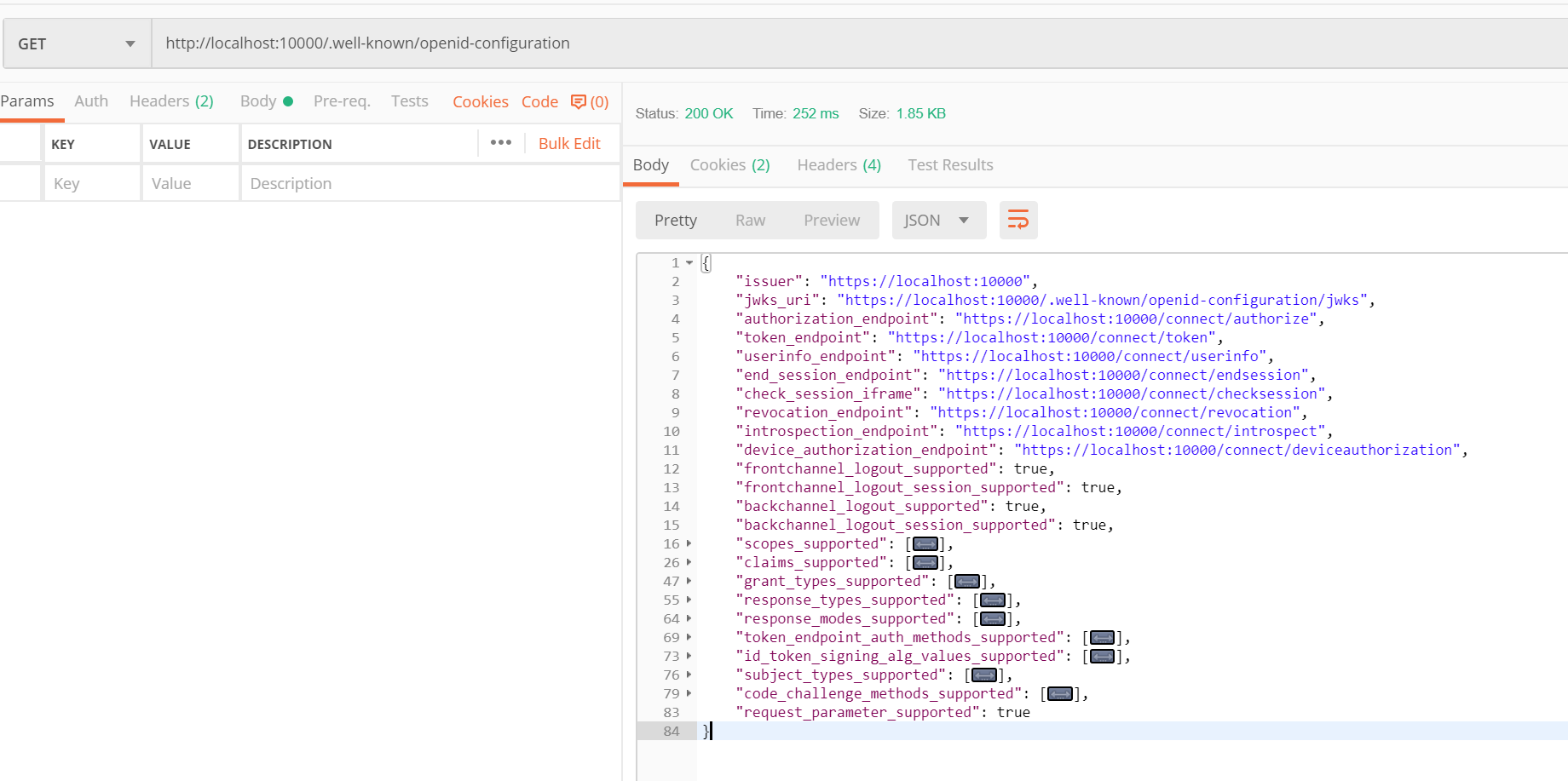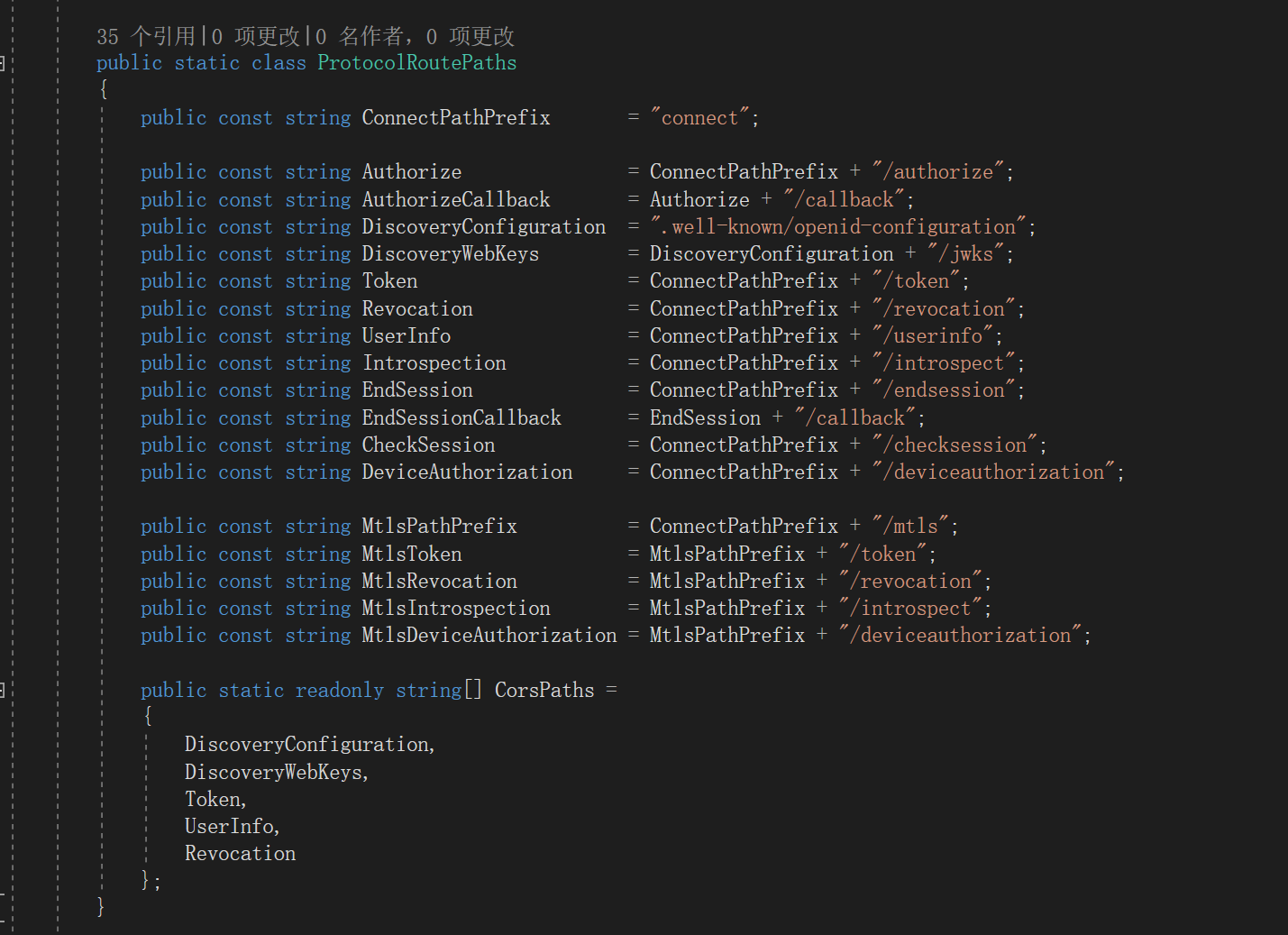identityserver4源码解析_2_元数据接口
目录
- IdentityServer4源码解析_1_项目结构
- IdentityServer4源码解析_2_元数据接口
- IdentityServer4源码解析_3_认证接口
- IdentityServer4源码解析_4_令牌发放接口
- IdentityServer4源码解析_5_查询用户信息接口
- [IdentityServer4源码解析_6_结束会话接口]
- [IdentityServer4源码解析_7_查询令牌信息接口]
- [IdentityServer4源码解析_8_撤销令牌接口]
协议
这一系列我们都采用这样的方式,先大概看下协议,也就是需求描述,然后看idsv4怎么实现的,这样可以加深理解。
元数据接口的协议地址如下:
摘要
该协议定义了一套标准,用户能够获取到oidc服务的基本信息,包括OAuth2.0相关接口地址。
Webfinger - 网络指纹
先了解一下Webfinger这个概念。
WebFinger可以翻译成网络指纹,它定义了一套标准,描述如何通过标准的HTTP方法去获取网络实体的资料信息。WebFinger使用JSON来描述实体信息。
查询oidc服务元数据 - OpenID Provider Issuer Discovery
可选协议。
定义了如何获取oidc服务元数据。如果客户端明确知道oidc服务的地址,可以跳过此部分。
个人理解是存在多个oidc服务的情况,可以部署一个webfinger服务,根据资源请求,路由到不同的oidc服务。
通常来说,我们只有一个oidc服务,我看了一下idsv4也没有实现这一部分协议,这里了解一下就可以了。
查询oidc服务配置信息 - OpenID Provider Configuration Request
必选协议。
用于描述oidc服务各接口地址及其他配置信息。
GET /.well-known/openid-configuration HTTP/1.1
Host: example.com
必须校验issuer与请求地址是否一致
启个idsrv服务调用试一下,返回结果如图

详细信息如下。
{
"issuer": "https://localhost:10000", //颁发者地址
"jwks_uri": "https://localhost:10000/.well-known/openid-configuration/jwks", //jwks接口地址,查询密钥
"authorization_endpoint": "https://localhost:10000/connect/authorize", //认证接口地址
"token_endpoint": "https://localhost:10000/connect/token", //令牌发放接口
"userinfo_endpoint": "https://localhost:10000/connect/userinfo", //查询用户信息接口
"end_session_endpoint": "https://localhost:10000/connect/endsession", //结束会话接口
"check_session_iframe": "https://localhost:10000/connect/checksession", //检查会话接口
"revocation_endpoint": "https://localhost:10000/connect/revocation", //撤销令牌接口
"introspection_endpoint": "https://localhost:10000/connect/introspect", //查询令牌详情接口
"device_authorization_endpoint": "https://localhost:10000/connect/deviceauthorization", //设备认证接口
"frontchannel_logout_supported": true, //是否支持前端登出
"frontchannel_logout_session_supported": true, //是否支持前端结束会话
"backchannel_logout_supported": true, //是否支持后端登出
"backchannel_logout_session_supported": true, //是否支持后端结束会话
"scopes_supported": [ //支持的授权范围,scope
"openid",
"profile",
"userid",
"username",
"email",
"mobile",
"api",
"offline_access" //token过期可用refresh_token刷新换取新token
],
"claims_supported": [ //支持的声明
"sub",
"updated_at",
"locale",
"zoneinfo",
"birthdate",
"gender",
"preferred_username",
"picture",
"profile",
"nickname",
"middle_name",
"given_name",
"family_name",
"website",
"name",
"userid",
"username",
"email",
"mobile"
],
"grant_types_supported": [ //支持的认证类型
"authorization_code", //授权码模式
"client_credentials", //客户端密钥模式
"refresh_token", //刷新token
"implicit", //隐式流程, 一般用于单页应用javascript客户端
"password", //用户名密码模式
"urn:ietf:params:oauth:grant-type:device_code" //设备授权码
],
"response_types_supported": [ //支持的返回类型
"code", //授权码
"token", //通行令牌
"id_token", //身份令牌
"id_token token", //身份令牌+统通行令牌
"code id_token", //授权码+身份令牌
"code token", //授权码+通行令牌
"code id_token token" //授权码+身份令牌+通行令牌
],
"response_modes_supported": [ //支持的响应方法
"form_post", //form-post提交
"query", //get提交
"fragment" //fragment提交
],
"token_endpoint_auth_methods_supported": [ //发放令牌接口支持的认证方式
"client_secret_basic", //basic
"client_secret_post" //post
],
"id_token_signing_alg_values_supported": [ //身份令牌加密算法
"RS256"
],
"subject_types_supported": [
"public"
],
"code_challenge_methods_supported": [
"plain",
"S256"
],
"request_parameter_supported": true
}
JWK - Json Web Keys
idsv还注入这样一个接口:DiscoveryKeyEndpoint,尝试发现返回了一组密钥。协议内容如下。
GET /.well-known/openid-configuration/jwks,返回结果如下
{
"keys": [
{
"kty": "RSA",
"use": "sig",
"kid": "LS-EQOr-3BkalkkUVh8q7Q",
"e": "AQAB",
"n": "08BLLaTz4JrTYmE4bZ9c7oKVrZKLy3KfGT5mmnslhl41nk_EV_8OUdL8wMXunC2KERdnsy5XYk4aw3LlvxZDIvjxO9PEblPsoap-WErdi9GVyAv-NJ6eJQy3S7FRSkvzQYBsLnCKm5wu0kjdQBVUCFJ7wfiZ9ayY7pH7K10qN2Utvt-qsCLUy0cJ0StuP_rquefp7_XhUw3A8IIA8P6DjfZIbpwrVjOeVWoI_ZKIwfxShghOAKBDLyQuC2PhozsqZ7HvGEeAPm06YPMWQVbE9_LBn2j_Ul_VBUWc9KfBNOzk_BMQHyF2NUlwMtqMUEcwK_hpjEeo62O_aFT8EDkgcQ",
"alg": "RS256"
},
{
"kty": "RSA",
"use": "sig",
"kid": "LS-EQOr-3BkalkkUVh8q7Q",
"e": "AQAB",
"n": "08BLLaTz4JrTYmE4bZ9c7oKVrZKLy3KfGT5mmnslhl41nk_EV_8OUdL8wMXunC2KERdnsy5XYk4aw3LlvxZDIvjxO9PEblPsoap-WErdi9GVyAv-NJ6eJQy3S7FRSkvzQYBsLnCKm5wu0kjdQBVUCFJ7wfiZ9ayY7pH7K10qN2Utvt-qsCLUy0cJ0StuP_rquefp7_XhUw3A8IIA8P6DjfZIbpwrVjOeVWoI_ZKIwfxShghOAKBDLyQuC2PhozsqZ7HvGEeAPm06YPMWQVbE9_LBn2j_Ul_VBUWc9KfBNOzk_BMQHyF2NUlwMtqMUEcwK_hpjEeo62O_aFT8EDkgcQ",
"alg": "RS256"
}
]
}
源码解析
接口地址都在Constants.cs这个文件,ProtocalRoutePaths这个类里面定义的。现在知道为什么接口地址是.well-known/openid-configuration这样奇怪的一个路由了,这是oidc协议定的(对,都是产品的锅)。

oidc服务配置信息接口 - DiscoveryEndpoint
代码很长,但是逻辑很简单,就是组装协议规定的所有地址和信息。
需要注意的支持的claims、支持的scope等信息是遍历所有IdentityResource、ApiResource动态获取的。
基本上每个接口都可以配置是否显示在元数据文档中。
public async Task<IEndpointResult> ProcessAsync(HttpContext context)
{
_logger.LogTrace("Processing discovery request.");
// validate HTTP
if (!HttpMethods.IsGet(context.Request.Method))
{
_logger.LogWarning("Discovery endpoint only supports GET requests");
return new StatusCodeResult(HttpStatusCode.MethodNotAllowed);
}
_logger.LogDebug("Start discovery request");
if (!_options.Endpoints.EnableDiscoveryEndpoint)
{
_logger.LogInformation("Discovery endpoint disabled. 404.");
return new StatusCodeResult(HttpStatusCode.NotFound);
}
var baseUrl = context.GetIdentityServerBaseUrl().EnsureTrailingSlash();
var issuerUri = context.GetIdentityServerIssuerUri();
// generate response
_logger.LogTrace("Calling into discovery response generator: {type}", _responseGenerator.GetType().FullName);
var response = await _responseGenerator.CreateDiscoveryDocumentAsync(baseUrl, issuerUri);
return new DiscoveryDocumentResult(response, _options.Discovery.ResponseCacheInterval);
}
/// <summary>
/// Creates the discovery document.
/// </summary>
/// <param name="baseUrl">The base URL.</param>
/// <param name="issuerUri">The issuer URI.</param>
public virtual async Task<Dictionary<string, object>> CreateDiscoveryDocumentAsync(string baseUrl, string issuerUri)
{
var entries = new Dictionary<string, object>
{
{ OidcConstants.Discovery.Issuer, issuerUri }
};
// jwks
if (Options.Discovery.ShowKeySet)
{
if ((await Keys.GetValidationKeysAsync()).Any())
{
entries.Add(OidcConstants.Discovery.JwksUri, baseUrl + Constants.ProtocolRoutePaths.DiscoveryWebKeys);
}
}
// endpoints
if (Options.Discovery.ShowEndpoints)
{
if (Options.Endpoints.EnableAuthorizeEndpoint)
{
entries.Add(OidcConstants.Discovery.AuthorizationEndpoint, baseUrl + Constants.ProtocolRoutePaths.Authorize);
}
if (Options.Endpoints.EnableTokenEndpoint)
{
entries.Add(OidcConstants.Discovery.TokenEndpoint, baseUrl + Constants.ProtocolRoutePaths.Token);
}
if (Options.Endpoints.EnableUserInfoEndpoint)
{
entries.Add(OidcConstants.Discovery.UserInfoEndpoint, baseUrl + Constants.ProtocolRoutePaths.UserInfo);
}
if (Options.Endpoints.EnableEndSessionEndpoint)
{
entries.Add(OidcConstants.Discovery.EndSessionEndpoint, baseUrl + Constants.ProtocolRoutePaths.EndSession);
}
if (Options.Endpoints.EnableCheckSessionEndpoint)
{
entries.Add(OidcConstants.Discovery.CheckSessionIframe, baseUrl + Constants.ProtocolRoutePaths.CheckSession);
}
if (Options.Endpoints.EnableTokenRevocationEndpoint)
{
entries.Add(OidcConstants.Discovery.RevocationEndpoint, baseUrl + Constants.ProtocolRoutePaths.Revocation);
}
if (Options.Endpoints.EnableIntrospectionEndpoint)
{
entries.Add(OidcConstants.Discovery.IntrospectionEndpoint, baseUrl + Constants.ProtocolRoutePaths.Introspection);
}
if (Options.Endpoints.EnableDeviceAuthorizationEndpoint)
{
entries.Add(OidcConstants.Discovery.DeviceAuthorizationEndpoint, baseUrl + Constants.ProtocolRoutePaths.DeviceAuthorization);
}
if (Options.MutualTls.Enabled)
{
var mtlsEndpoints = new Dictionary<string, string>();
if (Options.Endpoints.EnableTokenEndpoint)
{
mtlsEndpoints.Add(OidcConstants.Discovery.TokenEndpoint, baseUrl + Constants.ProtocolRoutePaths.MtlsToken);
}
if (Options.Endpoints.EnableTokenRevocationEndpoint)
{
mtlsEndpoints.Add(OidcConstants.Discovery.RevocationEndpoint, baseUrl + Constants.ProtocolRoutePaths.MtlsRevocation);
}
if (Options.Endpoints.EnableIntrospectionEndpoint)
{
mtlsEndpoints.Add(OidcConstants.Discovery.IntrospectionEndpoint, baseUrl + Constants.ProtocolRoutePaths.MtlsIntrospection);
}
if (Options.Endpoints.EnableDeviceAuthorizationEndpoint)
{
mtlsEndpoints.Add(OidcConstants.Discovery.DeviceAuthorizationEndpoint, baseUrl + Constants.ProtocolRoutePaths.MtlsDeviceAuthorization);
}
if (mtlsEndpoints.Any())
{
entries.Add(OidcConstants.Discovery.MtlsEndpointAliases, mtlsEndpoints);
}
}
}
// logout
if (Options.Endpoints.EnableEndSessionEndpoint)
{
entries.Add(OidcConstants.Discovery.FrontChannelLogoutSupported, true);
entries.Add(OidcConstants.Discovery.FrontChannelLogoutSessionSupported, true);
entries.Add(OidcConstants.Discovery.BackChannelLogoutSupported, true);
entries.Add(OidcConstants.Discovery.BackChannelLogoutSessionSupported, true);
}
// scopes and claims
if (Options.Discovery.ShowIdentityScopes ||
Options.Discovery.ShowApiScopes ||
Options.Discovery.ShowClaims)
{
var resources = await ResourceStore.GetAllEnabledResourcesAsync();
var scopes = new List<string>();
// scopes
if (Options.Discovery.ShowIdentityScopes)
{
scopes.AddRange(resources.IdentityResources.Where(x => x.ShowInDiscoveryDocument).Select(x => x.Name));
}
if (Options.Discovery.ShowApiScopes)
{
var apiScopes = from api in resources.ApiResources
from scope in api.Scopes
where scope.ShowInDiscoveryDocument
select scope.Name;
scopes.AddRange(apiScopes);
scopes.Add(IdentityServerConstants.StandardScopes.OfflineAccess);
}
if (scopes.Any())
{
entries.Add(OidcConstants.Discovery.ScopesSupported, scopes.ToArray());
}
// claims
if (Options.Discovery.ShowClaims)
{
var claims = new List<string>();
// add non-hidden identity scopes related claims
claims.AddRange(resources.IdentityResources.Where(x => x.ShowInDiscoveryDocument).SelectMany(x => x.UserClaims));
// add non-hidden api scopes related claims
foreach (var resource in resources.ApiResources)
{
claims.AddRange(resource.UserClaims);
foreach (var scope in resource.Scopes)
{
if (scope.ShowInDiscoveryDocument)
{
claims.AddRange(scope.UserClaims);
}
}
}
entries.Add(OidcConstants.Discovery.ClaimsSupported, claims.Distinct().ToArray());
}
}
// grant types
if (Options.Discovery.ShowGrantTypes)
{
var standardGrantTypes = new List<string>
{
OidcConstants.GrantTypes.AuthorizationCode,
OidcConstants.GrantTypes.ClientCredentials,
OidcConstants.GrantTypes.RefreshToken,
OidcConstants.GrantTypes.Implicit
};
if (!(ResourceOwnerValidator is NotSupportedResourceOwnerPasswordValidator))
{
standardGrantTypes.Add(OidcConstants.GrantTypes.Password);
}
if (Options.Endpoints.EnableDeviceAuthorizationEndpoint)
{
standardGrantTypes.Add(OidcConstants.GrantTypes.DeviceCode);
}
var showGrantTypes = new List<string>(standardGrantTypes);
if (Options.Discovery.ShowExtensionGrantTypes)
{
showGrantTypes.AddRange(ExtensionGrants.GetAvailableGrantTypes());
}
entries.Add(OidcConstants.Discovery.GrantTypesSupported, showGrantTypes.ToArray());
}
// response types
if (Options.Discovery.ShowResponseTypes)
{
entries.Add(OidcConstants.Discovery.ResponseTypesSupported, Constants.SupportedResponseTypes.ToArray());
}
// response modes
if (Options.Discovery.ShowResponseModes)
{
entries.Add(OidcConstants.Discovery.ResponseModesSupported, Constants.SupportedResponseModes.ToArray());
}
// misc
if (Options.Discovery.ShowTokenEndpointAuthenticationMethods)
{
var types = SecretParsers.GetAvailableAuthenticationMethods().ToList();
if (Options.MutualTls.Enabled)
{
types.Add(OidcConstants.EndpointAuthenticationMethods.TlsClientAuth);
types.Add(OidcConstants.EndpointAuthenticationMethods.SelfSignedTlsClientAuth);
}
entries.Add(OidcConstants.Discovery.TokenEndpointAuthenticationMethodsSupported, types);
}
var signingCredentials = await Keys.GetSigningCredentialsAsync();
if (signingCredentials != null)
{
var algorithm = signingCredentials.Algorithm;
entries.Add(OidcConstants.Discovery.IdTokenSigningAlgorithmsSupported, new[] { algorithm });
}
entries.Add(OidcConstants.Discovery.SubjectTypesSupported, new[] { "public" });
entries.Add(OidcConstants.Discovery.CodeChallengeMethodsSupported, new[] { OidcConstants.CodeChallengeMethods.Plain, OidcConstants.CodeChallengeMethods.Sha256 });
if (Options.Endpoints.EnableAuthorizeEndpoint)
{
entries.Add(OidcConstants.Discovery.RequestParameterSupported, true);
if (Options.Endpoints.EnableJwtRequestUri)
{
entries.Add(OidcConstants.Discovery.RequestUriParameterSupported, true);
}
}
if (Options.MutualTls.Enabled)
{
entries.Add(OidcConstants.Discovery.TlsClientCertificateBoundAccessTokens, true);
}
// custom entries
if (!Options.Discovery.CustomEntries.IsNullOrEmpty())
{
foreach (var customEntry in Options.Discovery.CustomEntries)
{
if (entries.ContainsKey(customEntry.Key))
{
Logger.LogError("Discovery custom entry {key} cannot be added, because it already exists.", customEntry.Key);
}
else
{
if (customEntry.Value is string customValueString)
{
if (customValueString.StartsWith("~/") && Options.Discovery.ExpandRelativePathsInCustomEntries)
{
entries.Add(customEntry.Key, baseUrl + customValueString.Substring(2));
continue;
}
}
entries.Add(customEntry.Key, customEntry.Value);
}
}
}
return entries;
}
然后是jwks描述信息的代码。关于加密的信息也是根据配置的SecuritKey去动态返回的。
public virtual async Task<IEnumerable<Models.JsonWebKey>> CreateJwkDocumentAsync()
{
var webKeys = new List<Models.JsonWebKey>();
foreach (var key in await Keys.GetValidationKeysAsync())
{
if (key.Key is X509SecurityKey x509Key)
{
var cert64 = Convert.ToBase64String(x509Key.Certificate.RawData);
var thumbprint = Base64Url.Encode(x509Key.Certificate.GetCertHash());
if (x509Key.PublicKey is RSA rsa)
{
var parameters = rsa.ExportParameters(false);
var exponent = Base64Url.Encode(parameters.Exponent);
var modulus = Base64Url.Encode(parameters.Modulus);
var rsaJsonWebKey = new Models.JsonWebKey
{
kty = "RSA",
use = "sig",
kid = x509Key.KeyId,
x5t = thumbprint,
e = exponent,
n = modulus,
x5c = new[] { cert64 },
alg = key.SigningAlgorithm
};
webKeys.Add(rsaJsonWebKey);
}
else if (x509Key.PublicKey is ECDsa ecdsa)
{
var parameters = ecdsa.ExportParameters(false);
var x = Base64Url.Encode(parameters.Q.X);
var y = Base64Url.Encode(parameters.Q.Y);
var ecdsaJsonWebKey = new Models.JsonWebKey
{
kty = "EC",
use = "sig",
kid = x509Key.KeyId,
x5t = thumbprint,
x = x,
y = y,
crv = CryptoHelper.GetCrvValueFromCurve(parameters.Curve),
x5c = new[] { cert64 },
alg = key.SigningAlgorithm
};
webKeys.Add(ecdsaJsonWebKey);
}
else
{
throw new InvalidOperationException($"key type: {x509Key.PublicKey.GetType().Name} not supported.");
}
}
else if (key.Key is RsaSecurityKey rsaKey)
{
var parameters = rsaKey.Rsa?.ExportParameters(false) ?? rsaKey.Parameters;
var exponent = Base64Url.Encode(parameters.Exponent);
var modulus = Base64Url.Encode(parameters.Modulus);
var webKey = new Models.JsonWebKey
{
kty = "RSA",
use = "sig",
kid = rsaKey.KeyId,
e = exponent,
n = modulus,
alg = key.SigningAlgorithm
};
webKeys.Add(webKey);
}
else if (key.Key is ECDsaSecurityKey ecdsaKey)
{
var parameters = ecdsaKey.ECDsa.ExportParameters(false);
var x = Base64Url.Encode(parameters.Q.X);
var y = Base64Url.Encode(parameters.Q.Y);
var ecdsaJsonWebKey = new Models.JsonWebKey
{
kty = "EC",
use = "sig",
kid = ecdsaKey.KeyId,
x = x,
y = y,
crv = CryptoHelper.GetCrvValueFromCurve(parameters.Curve),
alg = key.SigningAlgorithm
};
webKeys.Add(ecdsaJsonWebKey);
}
else if (key.Key is JsonWebKey jsonWebKey)
{
var webKey = new Models.JsonWebKey
{
kty = jsonWebKey.Kty,
use = jsonWebKey.Use ?? "sig",
kid = jsonWebKey.Kid,
x5t = jsonWebKey.X5t,
e = jsonWebKey.E,
n = jsonWebKey.N,
x5c = jsonWebKey.X5c?.Count == 0 ? null : jsonWebKey.X5c.ToArray(),
alg = jsonWebKey.Alg,
x = jsonWebKey.X,
y = jsonWebKey.Y
};
webKeys.Add(webKey);
}
}
return webKeys;
}
结语
这一节还是比较好理解的。总而言之就是oidc协议规定了,需要提供GET接口,返回所有接口的地址,以及相关配置信息。idsv4的实现方式就是接口地址根据协议规定的去拼接,其他配置项信息根据开发的配置去动态获取,然后以协议约定的JSON格式返回。
identityserver4源码解析_2_元数据接口的更多相关文章
- identityserver4源码解析_3_认证接口
目录 identityserver4源码解析_1_项目结构 identityserver4源码解析_2_元数据接口 identityserver4源码解析_3_认证接口 identityserver4 ...
- IdentityServer4源码解析_4_令牌发放接口
目录 identityserver4源码解析_1_项目结构 identityserver4源码解析_2_元数据接口 identityserver4源码解析_3_认证接口 identityserver4 ...
- IdentityServer4源码解析_5_查询用户信息接口
协议简析 UserInfo接口是OAuth2.0中规定的需要认证访问的接口,可以返回认证用户的声明信息.请求UserInfo接口需要使用通行令牌.响应报文通常是json数据格式,包含了一组claim键 ...
- IdentityServer4源码解析_1_项目结构
目录 IdentityServer4源码解析_1_项目结构 IdentityServer4源码解析_2_元数据接口 IdentityServer4源码解析_3_认证接口 IdentityServer4 ...
- Spring源码解析 - AbstractBeanFactory 实现接口与父类分析
我们先来看类图吧: 除了BeanFactory这一支的接口,AbstractBeanFactory主要实现了AliasRegistry和SingletonBeanRegistry接口. 这边主要提供了 ...
- 时序数据库 Apache-IoTDB 源码解析之元数据索引块(六)
上一章聊到 TsFile 索引块的详细介绍,以及一个查询所经过的步骤.详情请见: 时序数据库 Apache-IoTDB 源码解析之文件索引块(五) 打一波广告,欢迎大家访问 IoTDB 仓库,求一波 ...
- Java基础——集合源码解析 List List 接口
今天我们来学习集合的第一大体系 List. List 是一个接口,定义了一组元素是有序的.可重复的集合. List 继承自 Collection,较之 Collection,List 还添加了以下操作 ...
- 简单理解 OAuth 2.0 及资料收集,IdentityServer4 部分源码解析
简单理解 OAuth 2.0 及资料收集,IdentityServer4 部分源码解析 虽然经常用 OAuth 2.0,但是原理却不曾了解,印象里觉得很简单,请求跳来跳去,今天看完相关介绍,就来捋一捋 ...
- Spring-cloud & Netflix 源码解析:Eureka 服务注册发现接口 ****
http://www.idouba.net/spring-cloud-source-eureka-client-api/?utm_source=tuicool&utm_medium=refer ...
随机推荐
- 将js进行到底:node学习4
使用Node做web开发 HTTP与TCP 上一回使用node.js的NET(TCP)模块开发了一个聊天室demo.单纯用到了原始的TCP协议,可以说TCP是HTTP,SMTP,FTP的鼻祖了,后面的 ...
- 产品需求说明书PRD模版
<软件自动化测试开发>出版了 XXX产品需求说明书 [版本号:V+数字] 编 制: 日 期: 评 审: 日 期: 批 准: 日 期: ...
- 会编程的 AI + 会修 Bug 的 AI,等于什么 ?
2017-02-25 Python开发者 (点击上方公众号,可快速关注) 关于人工智能未来的畅想,除了家庭服务机器人,快递无人机,医用机器人等等,Lucas Carlson 认为人工智能在另外一个领域 ...
- 《AndroidStudio导入安卓源码-idegen》---可方便查看安卓源代码
idegen是Android源码中的一个模块,需要编译一下.生成一个jar包.然后再进行构建生成AndroidStudio配置相关文件. > 什么是idegen 要将Android系统源代码工程 ...
- AF(操作者框架)系列(3)-创建第一个Actor的程序
这节课的内容,语言描述基本是无趣的,就是一个纯程序编写,直接上图了. 如果想做其他练习,可参考前面的文章: https://zhuanlan.zhihu.com/p/105133597 1. 新建一个 ...
- JSR310-新日期APIJSR310新日期API(完结篇)-生产实战
前提 前面通过五篇文章基本介绍完JSR-310常用的日期时间API以及一些工具类,这篇博文主要说说笔者在生产实战中使用JSR-310日期时间API的一些经验. 系列文章: JSR310新日期API(一 ...
- ArrayList集合不能使用foreach增加、删除、修改元素的原因
大家先看两段代码 第一段代码: List<String> arrayList1 = new ArrayList<String>(); arrayList1.add(" ...
- 使用web写UI, 使用js对接C++项目, 提高开发效率
ppt资源下载地址https://www.slidestalk.com/s/webui_nodejs_cmdlrx
- BEM命名及其在sass中的实践
Why use it 近几年web应用的发展可以用疯狂来形容,依靠浏览器的支持以及前端技术和框架的发展,很多应用已经把大量的逻辑从服务器端迁移到了浏览器端,使用前后端分离技术,浏览器端与用户进行交互来 ...
- Linq的整型或实体类null引发的报错问题
经常在程序中遇到两个空值报错问题: 问题1:int类型如果为不可空,假如传进去null,会报错 问题2:EF的获得单个实体的Model如果为空,那么后面如果跟上属性会报错 解决问题1: 一般属性都设为 ...
